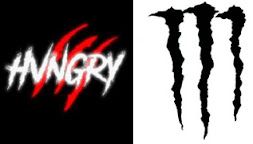I don't like to accuse any party of being a bully. I understand the trademark owner's duty to police its marks. But this case has tested my resolve. The Board dismissed this opposition to registration of the mark shown below left, for "t-shirts," finding no likelihood of confusion with Monster Energy's design mark shown below right, for clothing, including t-shirts. Comparing the marks in their entireties, the Board found (not surprisingly) that "the marks have almost nothing in common ... and ... they are quite dissimilar overall." That finding, along with Monster's failure to prove dilution-type fame, also sunk Monster's dilution-by-blurring claim. Monster Energy Company v. Jamal Jalen Carter, Opposition No. 91255846 (March 21, 2022) [not precedential] (Opinion by Judge Michael B. Adlin).

Likelihood of Confusion: Applicant Jamal Jalen Carter described his mark as "three red scratch marks behind the term 'HVNGRY' in white all against a black background." Monster Energy described its mark as "a stylized letter M in the form of a claw."
The Board found Monster's mark to be conceptually strong and famous for energy drinks, but there was no evidence that its mark is famous, or even commercially strong, for clothing. "[W]hile Opposer fairly extensively licenses its mark for use on clothing, its royalties from these licenses, while not insubstantial, are not particularly impressive either, especially because Opposer only provided 'worldwide' figures and there is no indication how many items of clothing bearing the pleaded marks have been sold in the United States."
Monster "hangs its hat" on the overall appearances of the marks, contending that "[t]he shape of the claw marks are highly similar. Both of the claw marks have rough, jagged edges ... and ... also have the identical number of claw marks three." The Board found that "while both marks contain three scratch/claw marks, and the scratch/claw marks are 'jagged,' the similarities in appearance end there."
[Wh]ile consumers will perceive Opposer's mark as merely an "M" or claw, they will perceive Applicant's mark as multifaceted, with the scratch marks serving to highlight the mark's literal element by running through the lettering , and the mark's red, white and black features distinguishing it from the less embellished features of Opposer's mark. In fact, Opposer's focus on the three red scratch marks in Applicant's mark essentially dissects it , which is not the proper way to compare marks.
The Board was unmoved by Monster's argument that the design element in Applicant Carter's mark is dominant. "[I] is settled that 'the verbal portion of a word and design mark likely will be the dominant portion ..'" In re Viterra, 101 USPQ2d at 1911.
The Board concluded that the marks "look quite different," sound "even more different," convey "entirely different meanings," and create "much different commercial impressions."
And so the Board dismissed Monster's Section 2(d) claim.
Dilution-by-Blurring: As to Monster's dilution-by-blurring claim, the Board found that Monster failed to proved that its mark is "widely recognized by the general consuming public of the United States as a designation of source of the goods or services of the mark's owner." [emphasis added]. In other words, Monster failed to show that its mark is a "household word."
[W]hile "niche" fame is sufficient to establish fame for likelihood of confusion purposes, it is not sufficient to establish fame for dilution purposes. As the Federal Circuit held in Coach Servs., a mark can acquire "sufficient public recognition and renown to be famous for purposes of likelihood of confusion without meeting the more stringent requirement for dilution fame."
While Monster's mark is famous for energy drinks, its fame ends there. "[T]he record as a whole comes nowhere close to establishing the widespread recognition among the general consuming public necessary to establish fame for dilution purposes."
The Lanham Act further requires that the party claiming dilution prove an "association arising from the similarity between a mark or trade name and a famous mark." Here, the marks are dissimilar in their entireties, "which precludes a finding of dilution, because consumers will not 'conjure up' Opposer's mark when they see Applicant's." And so, the Board dismissed Monster's dilution claim.
Read comments and post your comment here.
The content of this article is intended to provide a general guide to the subject matter. Specialist advice should be sought about your specific circumstances.

